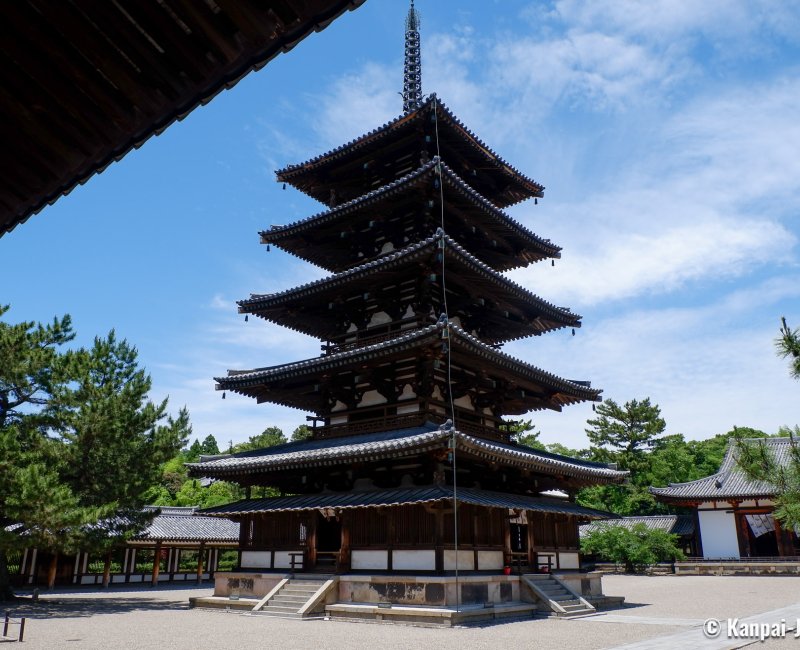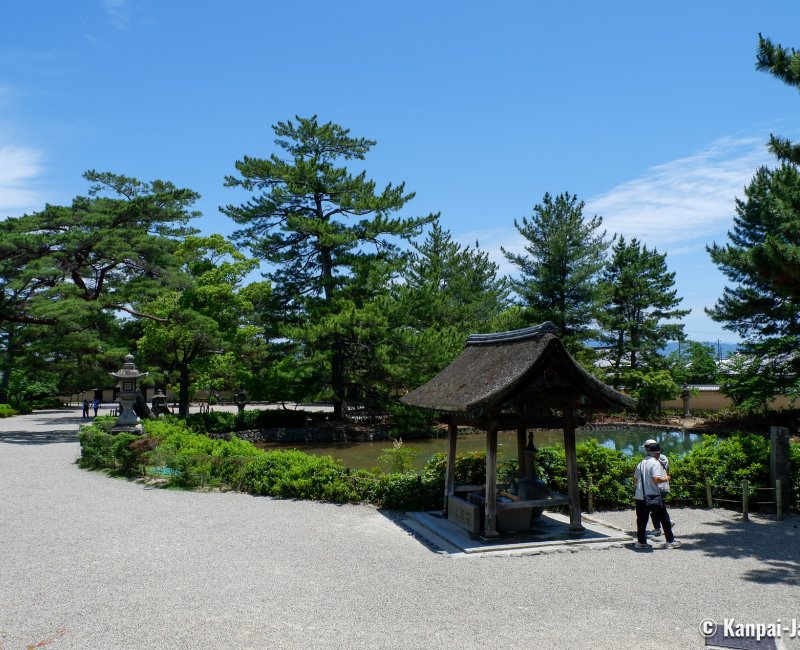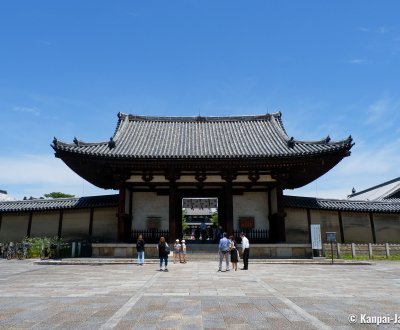Horyu-ji
Imperial Temple of Early Classical Japan
Horyu-ji is a Buddhist temple located in Ikaruga city, in the Ikoma district of Nara prefecture. As the first Japanese site enlisted in the UNESCO World Heritage in 1993, it preserves several wooden constructions of the end of the 7th century, as well as several ancient sculptures designated National Treasures.
Horyu-ji temple’s origins date back to the introduction of Buddhism in Japan. The first monastery was founded in 607 by Empress Suiko (554 - 628) and her regent Shotoku Taishi (574 – 622), near the latter’s palace in Ikaruga. It was burnt down in 670 and subsequently rebuilt slightly on the north-west, at its current location before the end of the 7th century. An extension toward east was built in the middle of the 8th century, at the location of the former palace, and other constructions were added over time.
The monastery, thanks to the imperial protection since its early days and the development of the cult of Shotoku Taishi in the 12th century, is nowadays well-preserved, despite a fire 🔥 in 1949 that damaged ancient paintings. Horyu-ji is enlisted in the UNESCO World Heritage since 1993 due to its abundance of artworks and buildings preserved since Classical Japan times: about 3,000 National Treasures or Important Cultural Assets.
Nowadays, the monastery complex extends over a 14,6 hectares superficies in the heart of Ikaruga city. An alley bordered by Japanese pine trees leads to the main gate Nandaimon opening on an earthen walls enclosure.
Preserved architecture of the Asuka period
A wide paved alley leads to the western part of the complex, Sai-in Garan, which is also the oldest. Horyu-ji is indeed famous for preserving some of the oldest wooden structures in the world, built during the Asuka period (538 – 710) in a characteristic architectural style:
- The cloister with covered galleries and the central gate Chumon have been completed in 693;
- The 32 meters high, 5-stories pagoda was built in the same year; and,
- The Kondo pavilion was completed in 679.

These buildings are testimony of Korean construction techniques introduced in Japan thanks to Shotoku Taishi and the promoters of Buddhism. The pagoda is displaying one of the first samples of an anti-seismic construction technique with a central pillar, that is still used nowadays in the most modern buildings, like the Tokyo SkyTree.
On the opposite side of the cloister’s central gate, the Daikodo pavilion was achieved in 990. It shelters a triad dedicated to Yakushi Nyorai, which is a group of statues dating to the same period. Note that taking picture of Buddhist statues is forbidden in most of the complex.
Treasure Hall and homage to Shotoku Taishi
At the exit of the Sai-in, visitors are directed toward a more modern hall, built in 1998 and called Daihozo-in, whose tiled roofs with slightly curved edges and wooden structures painted in vermilion remind of ancient architecture in the Heian period style. Daihozo-in is a treasure hall displaying some of the major pieces of Japanese Buddhist statuary art, including the miniature shrine Tamamushi no zushi. A signposted course helps navigating from National Treasure items to Important Cultural Properties collected over the centuries.
In 1878, Horyu-ji gave 300 other artworks to the National Museum of Tokyo, that are now displayed in the Horyu-ji Treasures gallery, a refined contemporary architecture building.
Then, a long paved alley leads to the eastern part of the site: To-in Garan. Its construction started in the 8th century, at the former location of Ikaruga Palace. The highlight of the area is the octagonal pavilion Yumedono ("the pavilion of dreams") built in 739 as a tribute to Shotoku Taishi. There is also an impressive Shuro bell tower topped by a heavy tile roof dating back to the Kamakura period.

Calm and serenity
The temple’s grounds is large enough for visitors to walk around comfortably. The site is flat overall with very few inclines, that are often compensated by sloping boards. Not all the historical or designated buildings are open to the public, but they are always identified along the way. As a matter of fact, make sure to keep your ticket until the end of the visit: it is indeed checked at the entrance of each area as the monastery is connected to the city and crossed by public streets.
There are 2 "rest areas" with toilets 🚽 at the beginning and in the middle of the visit course, where it is possible to sit and have a drink from vending machines. Such break can be essential, especially on hot weather days as the temple’s vegetation is scarce.
Horyu-ji and its surroundings can be explored over a 1-day trip, including Chugu-ji, an ancient convent located in its eastern part, or going to the Hokki-ji (built in the 7th century) and Horin-ji temples, and even Ikaruga-jinja shrine.



